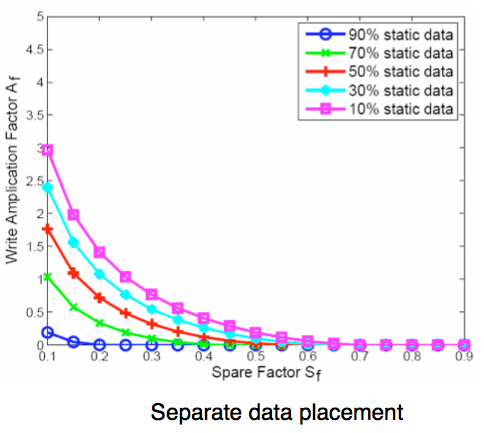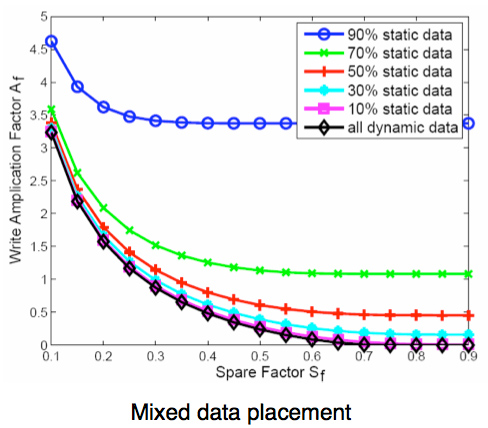The SSD Relapse: Understanding and Choosing the Best SSD
by Anand Lal Shimpi on August 30, 2009 12:00 AM EST- Posted in
- Storage
The Instruction That Changes (almost) Everything: TRIM
TRIM is an interesting command. It lets the SSD prioritize blocks for cleaning. In the example I used before, a block is cleaned only when the drive runs out of places to write things and has to dip into its spare area. With TRIM, if you delete a file, the OS sends a TRIM command to the drive along with the associated LBAs that are no longer needed. The TRIM command tells the drive that it can schedule those blocks for cleaning and add them to the pool of replacement blocks.
A used SSD will only have its spare area to use as a scratch pad for moving data around; on most consumer drives that’s around 7%. Take a look at this graph from a study IBM did on SSD performance:

Write Amplification vs. Spare Area, courtesy of IBM Zurich Research Laboratory
Note how dramatically write amplification goes down when you increase the percentage of spare area the drive has. In order to get down to a write amplification factor of 1 our spare area needs to be somewhere in the 10 - 30% range, depending on how much of the data on our drive is static.
Remember our pool of replacement blocks? This graph actually assumes that we have multiple pools of replacement blocks. One for frequently changing data (e.g. file tables, pagefile, other random writes) and one for static data (e.g. installed applications, data). If the SSD controller only implements a single pool of replacement blocks, the spare area requirements are much higher:

Write Amplification vs. Spare Area, courtesy of IBM Zurich Research Laboratory
We’re looking at a minimum of 30% spare area for this simpler algorithm. Some models don’t even drop down to 1.0x write amplification.
But remember, today’s consumer drives only ship with roughly 6 - 7% spare area on them. That’s under the 10% minimum even from our more sophisticated controller example. By comparison, the enterprise SSDs like Intel’s X25-E ship with more spare area - in this case 20%.
What TRIM does is help give well architected controllers like that in the X25-M more spare area. Space you’re not using on the drive, space that has been TRIMed, can now be used in the pool of replacement blocks. And as IBM’s study shows, that can go a long way to improving performance depending on your workload.










295 Comments
View All Comments
shabby - Monday, August 31, 2009 - link
The 80gig g2 is $399 now!gfody - Tuesday, September 1, 2009 - link
The gen2 80gb is at $499 as of 12:00AM PSTmaxfisher05 - Monday, August 31, 2009 - link
As of right now (8/31) newegg has the 160GB Intel G2 listed at $899!!!!!!!!!!!!!!!!!!! To quote Anand "lolqtfbbq!"siliq - Monday, August 31, 2009 - link
Great article! Love reading this. Thanks Anand.We gather from this article that all the pain-in-@$$ about SSDs come from the inconsistency between the size of the read-write page and the erase block. When SSDs are reading/writing a page it's 4K, but the minimum size of erasing operation is 512K. Just wondering is there any possibility that manufacturers can come up with NAND chips that allows controllers to directly erase a 4K page without all the extra hassles. What are the obstacles that prevent manufacturers from achieving this today?
bji - Tuesday, September 1, 2009 - link
It is my understanding that flash memory has already been pushed to its limit of efficiency in terms of silicon usage in order to allow for the lowest possible per-GB price. It is much cheaper to implement sophisticated controllers that hide the erase penalty as much as possible than it is to "fix" the issue in the flash memory itself.It is absolutely possible to make flash memory that has the characteristics you describe - 4K erase blocks - but it would require a very large number of extra gates in silicon and this would push the cost up per GB quite a bit. Just pulling numbers out of the air, let's say it would cost 2x as much per GB for flash with 4K erase blocks. People already complain about the high cost per GB of SSD drives (well I don't - because I don't steal software/music/movies so I have trouble filling even a 60 GB drive), I can't imagine that it would make market sense for any company to release an SSD based on flash memory that costs $7 per GB, especially when incredible performance can be achieved using standard flash, which is already highly optimized for price/performance/size as much as possible, as long as a sufficiently smart controller is used.
Also - you should read up on NOR flash. This is a different technology that already exists, that has small erase blocks and is probably just what you're asking for. However, it uses 66% more silicon area than equivalent NAND flash (the flash used in SSD drives), so it is at least 66% more expensive. And no one uses it in SSDs (or other types of flash drives AFAIK) for this reason.
bji - Tuesday, September 1, 2009 - link
Oh I just noticed in the Wikipedia article about NOR flash, that typical NOR flash erase block sizes are also 64, 128, or 256 KB. So the eraseblocks are just as problematic there as in NAND flash. However, NOR flash is more easily bit-addressable so would avoid some of the other penalties associated with NAND that the smart contollers have to work around.So to make a NAND or NOR flash with 4K eraseblocks would probably make them both 2X - 4X more expensive. No one is going to do that - it would push the price back out to where SSDs were not viable, just as they were a few years ago.
siliq - Tuesday, September 1, 2009 - link
Amazing answers! Thank you very muchmorrie - Monday, August 31, 2009 - link
My laptop is limited to 4 GB swap. While that's enough for 99% of Linux users, I don't shut down my laptop, it's used as a desktop with dozens of apps running and hundreds of browser tabs. Therefore, after a few months of uptime, memory usage climbs above 4 GB. I have two hard drives in the laptop, and set up a software raid0 1GB swap partition, but I went with software raid1 for the other swap partition. So once the ram is used up for swap, the laptop slows noticeably, but after the raid0 swap partition fills up, the raid1 partition really slows it down. Once that fills up, it hits swap files (non raid) which slow it down more. But thanks to the kernel and the way swappiness works, once about 4 GB of Ram plus about 3 GB of physical swap is used, it really slows. I can gain a bit of speed by adding some physical swap files to increase the ratio of physical swap to ram swap (thus changing swappiness through other means), but this only works for another 1 GB of ram.No lectures or advice please, on how I'm using up memory or about how 4GB is more than sufficient, my uptimes are in the hundreds of days on this laptop and thanks to ADD/limited attention span, intermittent printer availability for printing out saved browser tabs and other reasons (old habits dying hard being one), my memory usage is what it is.
So, the big question is, since the laptop has an eSATA port, can I install one of these ssd drives in an externel SATA tray, connected via eSATA to the laptop and move physical swap partitions to the ssd? I believe that swap on the ssd would be a lot faster even on the eSATA wire, than swap on the drives in the laptop (they're 7200 rpm drives btw). I'm aware that using the ssd for swap would shorten it's life, but if it lasts a year till faster laptops with more memory are available (and I get used to virtual machines and saving state so I can limit open browser windows), I'll be happy.
Buying two of the drives and using them raided in the laptop is too costly right now, when prices drop that'll be a solution for this current laptop.
Externel SSD over eSATA for Linux swap on a laptop? Faster than my current setup?
hpr - Monday, August 31, 2009 - link
Sounds like you have some very small memory leak going on there.Have you tried that Firefox plugin that enables you to have your tabs but it doesn't really have a tab open in memory.
TooManyTabs
https://addons.mozilla.org/en-US/firefox/addon/942...">https://addons.mozilla.org/en-US/firefox/addon/942...
Have fun filling up thousands of tabs and having low memory usage.
gstrickler - Monday, August 31, 2009 - link
You should be able to use an SSD in an eSATA case, and yes, it should be faster than using your internal 7200 RPM drives. You probably want to use an Intel SSD for that (see page 19 of the article and note that the Intel drives don't drop off dramatically with usage).If you don't need to storage of your two internal 7200 RPM drives (or if you can get a sufficiently large SSD), you might be better off replacing one of them with an SSD and reconsider how you're allocating all your storage.
As for printer availability, seems to me it would make more sense to use a CUPS based setup to create PDFs rather than having jobs sit in a print queue indefinitely. Then, print the PDFs at your convenience when you have a printer available. I don't know how your printing setup currently works, but it sounds like doing so would reduce your swap space usage.